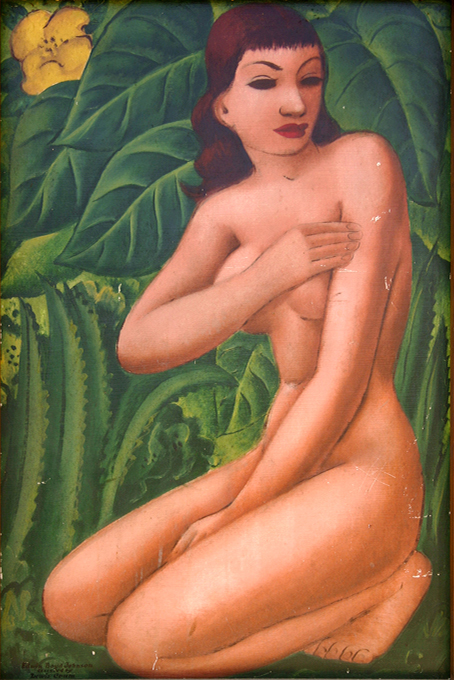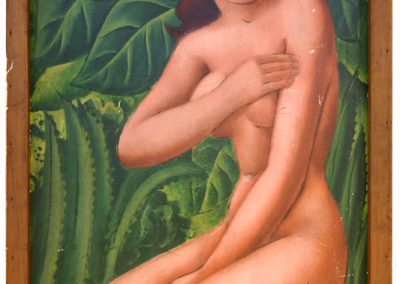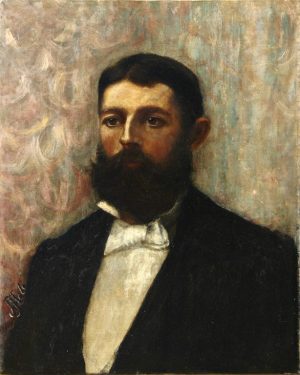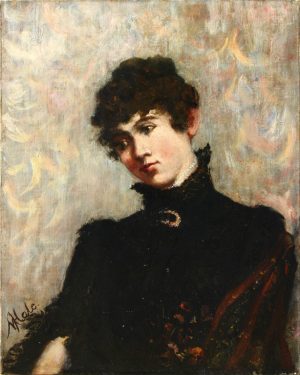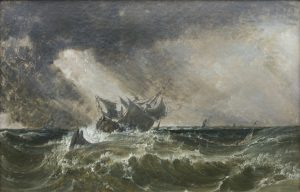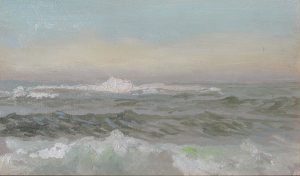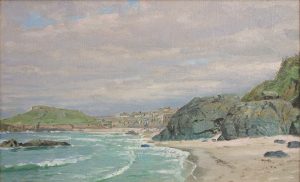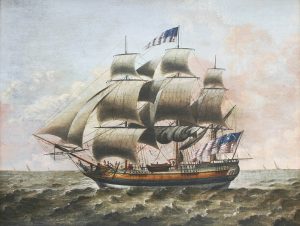Edwin Boyd Johnson (American, 1904-1968)
American artist Edwin Boyd Johnson was born in Watertown, Tennessee on November 4, 1904. Shortly after his birth, the family moved to Nashville where he attended Rosemont Grade School and Central High School. Due to a strained financial situation, Johnson worked days as a sign painter for General Outdoor Advertising Company in his senior year and attended school at night. After high school, he studied art at the Watkins College of Art, Design and Film.
In 1925 Johnson enrolled in the Art Institute of Chicago, graduating in 1930. Following his graduation, he studied for a year at the National Academy in New York City. As a member of the Chicago Society of Artists, Johnson exhibited at the Art Institute of Chicago during the 1930’s. He also exhibited his paintings at the Brooklyn Museum (1935), the Cincinnati Art Museum (1939), and the Pennsylvania Academy of Fine Arts (1939).
Johnson was also the recipient of several awards and scholarships. In 1938, his oil painting, “Nude”, was awarded the Joseph N. Eisendrath Prize, and in 1940, the Art Institute Alumni Association awarded “Mother and Child” the William M. R. French Memorial Gold Medal. The Lathrop European Fellowship prize enabled Johnson to study at the Kunstgewebe Schule in Vienna, the Ecole de Fresque in Paris, and the Ecole Egyptienne des Beaux Arts in Alexandria, Egypt, where he earned the Diploma of Honor from the Salon Alexandrie.
Upon his homecoming to the United States, Johnson returned to Chicago, where he was employed by the Works Progress Administration (WPA). This was the largest and most ambitious American New Deal agency, employing millions of unemployed people to carry out public works projects, including the construction of public buildings and roads. In a much smaller but more famous project, Federal Project Number One, the WPA employed musicians, artists, writers, actors and directors in large arts, drama, media, and literacy projects. Headed by Harry Hopkins, the WPA provided jobs and income to the unemployed during the Great Depression in the United States. At its peak in 1938, it provided paid jobs for three million unemployed men and women, as well as youth in a separate division, the National Youth Administration.
In this capacity Johnson supervised the Elgin, Illinois, Project for the purpose of allocating works of art to various public buildings. He was later sent to Alaska to paint landscapes for a touring exhibit to promote Alaskan travel and tourism. His painting of Mt. Kimball hangs in the Anchorage Museum at the Rasmuson Center.
While Johnson painted in both water colors and oils, he is best known for his murals. WPA murals were selected by competition and funded by the WPA Federal Art Project. His important mural art includes the recently restored “Airmail” in the Melrose Park Library, Chicago (1937), “The Old Days” in the Tuscola, IL. Post Office (1941), the City Hall mural in Sioux Falls, SD, and a smaller work in the Saint Charles Public Library, IL (1935). Unfortunately, the following murals by Johnson are no longer open for public viewing: “People of the Soil” in Dixon, TN, which was photographed and included in the book, Tennessee Post Office Murals (1996), murals at the College of Fine Arts in Urbana, IL, and lobby murals at Flossmoor Public School, Flossmoor, IL.
In July of 1942 Johnson enlisted in the United States Navy Reserves. After indoctrination at Camp Allen, Norfolk, Virginia, he was deployed to the South Pacific, where he served for nearly two years. During this time, he painted numerous murals, among them panels for the NCB Officers Mess Hall on Tulagi, one of the smaller Salomon Islands. His cartoons were featured in Fore and Aft, the Okinawa service paper.
At the end of the war, Johnson returned to Nashville where he set up an art studio and taught at Watkins College of Art, Design and Film. Reestablishing himself, however, proved difficult. After several unsuccessful commercial ventures, he decided to take advantage of the G. I. Bill to pursue his interest in photography. He enrolled in La Esmeralda National School of Painting in Mexico City and studied with the well-known photographer, Dolores (Lola) Alvares Bravo. His work was also influenced by his friend Pablo O’Higgins, a disciple and painter’s assistant to Diego Rivera, and Gerardo Murillo, known as Dr. Atl, a noted painter of Mexican landscapes.
Johnson enjoyed success as a photographer as well as a muralist. He had several exhibits at the Mexican American Institute of Cultural Relations in Mexico City and won awards from Popular Photography magazine during the 1950’s. Although the magazine Artes de Mexico did not credit photographers, Johnson is said to be responsible for the issues “Marine Plant Life,” “Fresh Water Fish,” and “Haciendas of Mexico” (1965).
In addition to the murals cited above and the Mt. Kimball, Alaska painting, Johnson’s work can be seen in the Smithsonian’s publication, Season’s Greetings – Holiday Cards from the Archives of American Art, Nov. 20, 2009 – Jan 17, 2010, a fresco of nine panels entitled “Great Men of Medicine” at the University of Illinois Medical Center, College of Medicine and the lobby of the Cook County Hospital in Chicago, IL.
In later life failing health forced him to enter the Veterans Administration Hospital in Nashville where he died on August 6th, 1968.
Johnson’s murals can be seen in public buildings across the United States and his paintings are in American museum collections including the Smithsonian American Art Museum, the Anchorage Museum at Rasmuson Center, and the Georgia Museum of Art. His artworks rarely appear on the art market.
Nude Woman in Tropical Landscape, c.1942
by Edwin Boyd Johnson (American, 1904-1968)
| Medium | Oil |
| Medium Detail | Oil on masonite |
| Dimensions | 37 x 25 inches; Framed: 39 x 27 inches |
| Signed Location | Signed and inscribed "Assisted by Lewis Crum" lower left |
| Date Created | c.1942 |
| Comments | Period Frame |
Printable version
View additional works by Edwin Boyd Johnson
1 in stock
Contact Us About This Piece

